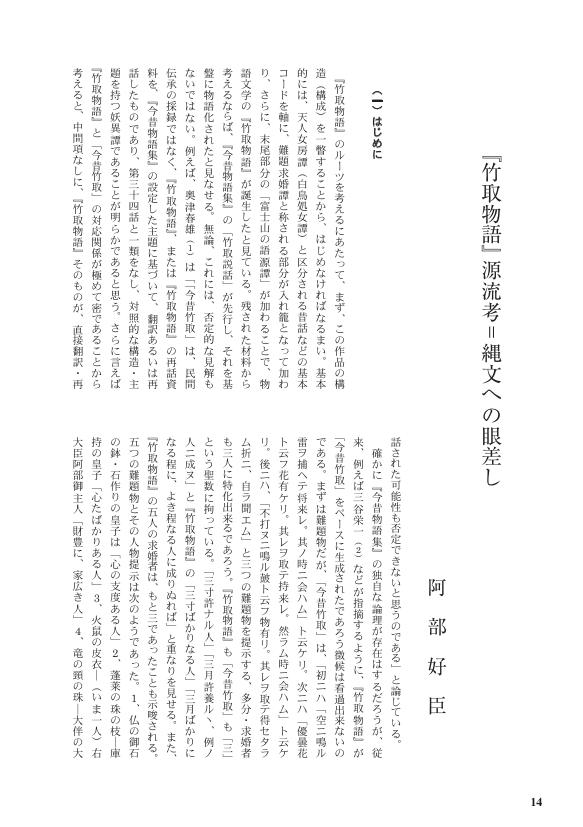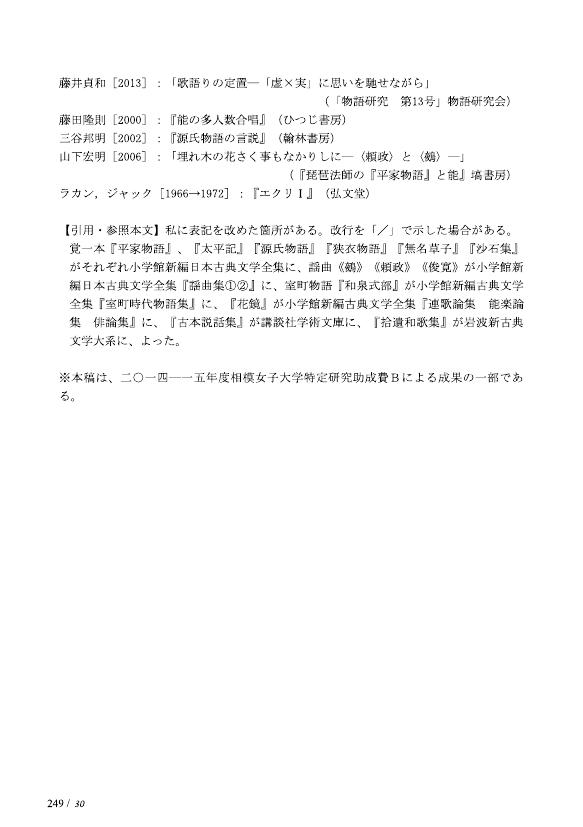- 著者
- 樋口 大祐
- 出版者
- 物語研究会
- 雑誌
- 物語研究 (ISSN:13481622)
- 巻号頁・発行日
- no.9, pp.32-44, 2009-03-31
This study was spurred by a precedent research by Makoto Takagi et al. and attempts to investigate the affiliations between "borei" (ghostly manifestations) and war chronicles (the interpretation centers around "onryoshikan" or historical insights of vindictive spirits). According to the five literary works (pieces of literature), The Tale of Hogen, The Tale of Heiji, The Tale of Heike, Shokyuki (The account of the Shokyu War), Taiheiki (Chronicle of the Grand Pacification), there are records pertaining to nation-wide famous "onryo" or vengeful ghosts across history such as Sutokuin, Emperor Antoku, Gotobain, and Emperor Daigo etc. However, despite The Tale of Hogen is a fundamental component surrounding the historical insight of the "onryo" or spirit belonging to Sutokuin, according to other sources, we have yet to come up with a rational justification of the many incidents concerning the occurrences of these appearances. While Shokyuki seems indifferent toward the ghost of Gotobain, The Tale of Heike and Taiheiki include "onryoshikan" or historical insights of vindictive spirits, though after all it resorts to other interpretations. On the other hand, since the term "borei" is utilized to express a wider meaning, Tairano Kiyomori's recollection in The Tale of Heike should be linked to current reliable methods (in insinuating that it existed in the past and yet shall continue to prevail in the future) and thus shall provide several perspectives related to "borei" or departed spirts in history.
1 0 0 0 OA 『竹取物語』 源流考=縄文への眼差し 阿部好臣
- 出版者
- 物語研究会
- 雑誌
- 物語研究 (ISSN:13481622)
- 巻号頁・発行日
- vol.18, pp.14-28, 2018 (Released:2021-07-01)
1 0 0 0 OA 小説家の眼差しの彼方に : 視線のドラマとしての泉鏡花「山海評判記」(テーマシンポジウム論文,年間テーマ「>〈見える/見えない〉の物語学」,<特集>〈見える/見えない〉の物語学)
- 著者
- 清水 潤
- 出版者
- 物語研究会
- 雑誌
- 物語研究 (ISSN:13481622)
- 巻号頁・発行日
- vol.10, pp.4-17, 2010-03-31 (Released:2018-03-27)
This study takes up Sankai Hyobanki as a novel representative of Izumi Kyoka's later career. By focusing on the protagonist Yano, who is a novelist, I examine the functions of the gaze with regard to the act of looking. The subject of the act of looking controls the object of the gaze. However, this power relation reverses when the object of the act of looking reveals its awareness of the gaze of the subject and the relation shifts into one of "showing" and "being showed." By considering the characters surrounding Yano in the novel, I show that changes in the angle of the gaze open up possibilities for new readings.
- 著者
- 本橋 裕美
- 出版者
- 物語研究会
- 雑誌
- 物語研究 (ISSN:13481622)
- 巻号頁・発行日
- vol.13, pp.3-14, 2013-03-31 (Released:2018-03-27)
Like history, a narrative has plural axes of time. However, when we read narrative, we seek for one axis of time. We deny incoherence, seek for coherence, and reconstruct a story. But The Tale of Genji, a text connected to history, does not allow the reduction to one axis of time. It reveals that it has plural axes of time, and it causes characters' past and present to waver. This wavering shakes our perception as well as the characters'. I will talk about "Engi," an era name defining time, and explain the intersection of "Fiction × Reality."
- 出版者
- 物語研究会
- 雑誌
- 物語研究 (ISSN:13481622)
- 巻号頁・発行日
- vol.19, pp.44-61, 2019 (Released:2022-06-18)
1 0 0 0 OA だれもが異人である世界での「異人論」とは何か
- 著者
- 一柳 廣孝
- 出版者
- 物語研究会
- 雑誌
- 物語研究 (ISSN:13481622)
- 巻号頁・発行日
- vol.22, pp.284-286, 2022-03-31 (Released:2023-04-01)
- 著者
- 一柳 廣孝
- 出版者
- 物語研究会
- 雑誌
- 物語研究 (ISSN:13481622)
- 巻号頁・発行日
- vol.9, pp.12-19, 2009-03-31 (Released:2018-03-27)
- 被引用文献数
- 1
In contemplating over how the recently established vindictive impression of "yuurei" (ghost) has changed during post-modern times, we shall attempt to heed to the notion of "shinrei" (spirit) as a medium. "Shinrei" was started to be applied in the context of spiritualism which was tinged by psychological and religious traces of the New Age during the "hanmon no jidai" (years of anguish/agony) in the mid thirty years of the Meiji Period. In respect of "reikon" (soul spirit) and "tamashii" (soul) that are deeply intertwined with the religious beliefs of the previous era, "shinrei"? was accepted as a new concept that wiped out earlier (former) images, in addition to being regarded as a key item concerning the debate over the actual existence of a "shinrei" from a scientific perspective. Thus, "shinrei" became the newly defined term in modern place. The main discourse in this study reflects over the expressions "shinrei" and "yuurei", especially employed from the late-Meiji era to the beginning of the Taisho period.
- 出版者
- 物語研究会
- 雑誌
- 物語研究 (ISSN:13481622)
- 巻号頁・発行日
- vol.20, pp.32-44, 2020 (Released:2022-06-18)
1 0 0 0 OA 猫のまなざしを追いかける―『源氏物語』と動物論
- 著者
- 西原 志保
- 出版者
- 物語研究会
- 雑誌
- 物語研究 (ISSN:13481622)
- 巻号頁・発行日
- vol.21, pp.16-30, 2021-03-31 (Released:2022-08-25)
1 0 0 0 OA 異議あり、一八世紀フランスのレトリックは転義法に「限定」されてはいない
- 著者
- ドゥエ フランソワーズ 黒木 朋興
- 出版者
- 物語研究会
- 雑誌
- 物語研究 (ISSN:13481622)
- 巻号頁・発行日
- vol.8, pp.74-84, 2008-03-31 (Released:2018-03-27)
Highly influenced by Dumarsais's treatise On Tropes (1730), French rhetoric in the 18th century was "restricted" to the study of models of signification or tropes. I shall propose here four historical counter-arguments to this thesis put forward by Gerard Genette in 1970. First, in the 18th century there is no relevant break in French rhetoric since it remained unrestricted from 1598 to 1885. Second, considered a grammar by its own author and a poetics by its contemporaries, the treatise On Tropes is not in fact significantly representative of the evolution of rhetoric. Third, even in the treatises of rhetoric influenced by Dumarsais, the part assigned to tropes remained unchanged throughout the 18th century. Fourth, some other aspects of rhetoric structure reveal a considerable amount of mobility in the 18th century: action, passions, design, models of construction and styles. In brief, though stimulating in 1970, this thesis of "restricted rhetoric" has nowadays become an epistemological obstacle to the understanding of the history of rhetoric in France.
1 0 0 0 OA 異言語間における言説分析―『源氏物語』 ロシア語訳の事例から アンダソヴァマラル
- 出版者
- 物語研究会
- 雑誌
- 物語研究 (ISSN:13481622)
- 巻号頁・発行日
- vol.18, pp.158-174, 2018 (Released:2021-07-01)
1 0 0 0 『うつほ物語』擦り寄る朱雀帝と仲忠 : 笑いを媒介に
- 著者
- 西山 登喜
- 出版者
- 物語研究会
- 雑誌
- 物語研究 (ISSN:13481622)
- 巻号頁・発行日
- vol.8, pp.106-118, 2008
The power relationship of the person alughs at and the person laughed at surfaces by 'laughter'. The act of laughing rules the situation. Here we study again the relation between the Emperor Suzaku and Nakatada from a new angle of 'laughter'. The Emperor Suzaku laughs at under the cooperation of Nakatada. The Emperor Suzaku tries to advocate the domination of the royal prerogative by laughing, and tries to seize the family of the Kin (seven-stringed Chinese koto). On the other hand, Nakatada rejects his own playing kin. With keeping the logic of 'Matsurohanu', he makes the Emperor Suzaku laugh and then he shows his indirect submission to the Emperor Suzaku by talking about the episode to others. The two persons form strange complicity while they are convinced that the logic of each other is not distorted mutually. The Emperor Suzaku's laughter hids the rising contradiction of both. The consideration to try to utilize and controll each other while checking the other is made and resonated by 'laughter.' 'Laughter' is the expression of the mind with assuming malediction.
- 著者
- 兵頭 裕己
- 出版者
- 物語研究会
- 雑誌
- 物語研究 (ISSN:13481622)
- 巻号頁・発行日
- vol.14, pp.4-15, 2014
In this essay, from the perspectives of point of view, person and subject of narrative, the performative characteristics of Japanese narrative discourse, namely The Tale of Genji and The Tale of Heike, are studied in detail.
1 0 0 0 『古今集』 の敬語表現と主体/客体、 人称 布村浩一
- 出版者
- 物語研究会
- 雑誌
- 物語研究 (ISSN:13481622)
- 巻号頁・発行日
- vol.18, pp.99-107, 2018
- 出版者
- 物語研究会
- 雑誌
- 物語研究 (ISSN:13481622)
- 巻号頁・発行日
- vol.18, pp.90-98, 2018
1 0 0 0 OA 『源氏物語』における須磨の空間表現 : 光源氏の生活空間を中心に
- 著者
- 岩森 円花
- 出版者
- 物語研究会
- 雑誌
- 物語研究 (ISSN:13481622)
- 巻号頁・発行日
- vol.14, pp.122-138, 2014-03-31 (Released:2018-03-27)
The area of Suma is influenced by many preceding stories and traditions in the text of The Suma chapter of The Tale of Genji, but it has been recognized as a fixed image related to the sea, it is the dreary place that where an exile lives. However, when looked upon as the living-space of Hikaru Genji, the place Suma is described as a space having both elements of the sea and the mountain, without the description leaving a consistent impression. In this paper, I analyze the living-space of Hikaru Genji with regards to the story text. I point out that the sea of Suma emphasizes the dreariness and lonesomeness of Hikaru Genji by the image of Waka, and that the mountain shows a bearing of Hikaru Genji as a recluse calmly content in heart through the image of Chinese poetry while being related with a pseudo-priestly life. Furthermore, I treat that space of Suma that has been treated relative to the capital switches as a bordering space leading to the ground Akashi from the purification ceremony of the beginning of March.
- 出版者
- 物語研究会
- 雑誌
- 物語研究 (ISSN:13481622)
- 巻号頁・発行日
- vol.16, pp.260, 2016 (Released:2019-04-20)
- 著者
- 圷 美奈子
- 出版者
- 物語研究会
- 雑誌
- 物語研究 (ISSN:13481622)
- 巻号頁・発行日
- vol.8, pp.20-32, 2008-03-31 (Released:2018-03-27)
The 31-syllable Japanese poems can express not only real scenery and feeling. Surely, to express the ideal world by the poems led great progress of Japanese expression. The technique "mitate" is one of the most impotant expressions. But the matter to be examined by this paper is different from "mitate" which is typical arts of "the Kokinshuu" for example to watch snow as a flower. By this paper, I will point it out about the art of poems which was not noticed till now. It is expression to replace reality with other matters. It may be said that it is a kind of technique of so-called "mitate." However, it is not the figurativ expression. It is the technique to express the matter that you should express definitely. In other words the technique of expression concerns the essence of the poems. Those poems take the form of question and answer by two people. The follwing expressions about Sei-shounagon are in The Makura-no-soushi (The Pillow-Book of Sei-Shounagon)." One is "you,who are called after Motosuke." The other is "the barrier which is easy to pass through." Both expressions have been merely understood in the literal meaning superficially. The former is "the person who should make good poems," the latter is "a frivolous woman." But these are not quite correct. There are the special existence and events as the basis of these expressions. Also I examine the examples of "the Manyoushuu (1-20・21)", "The Tale of Genji" and "The Ise Story" by this paper. This technique to replace reality with some others is technology to let reality sublimate to a better thing by the power of words,which are poems. If the dual structure of the certain poems are not understood, we will continue watching only illusion.
1 0 0 0 OA 三谷邦明著, 『源氏物語の方法-〈もののまぎれ〉の極北』
- 著者
- 斉藤 昭子
- 出版者
- 物語研究会
- 雑誌
- 物語研究 (ISSN:13481622)
- 巻号頁・発行日
- vol.9, pp.184-186, 2009-03-31 (Released:2018-03-27)
- 著者
- 松岡 智之
- 出版者
- 物語研究会
- 雑誌
- 物語研究 (ISSN:13481622)
- 巻号頁・発行日
- vol.11, pp.191-193, 2011-03-31 (Released:2018-03-27)








